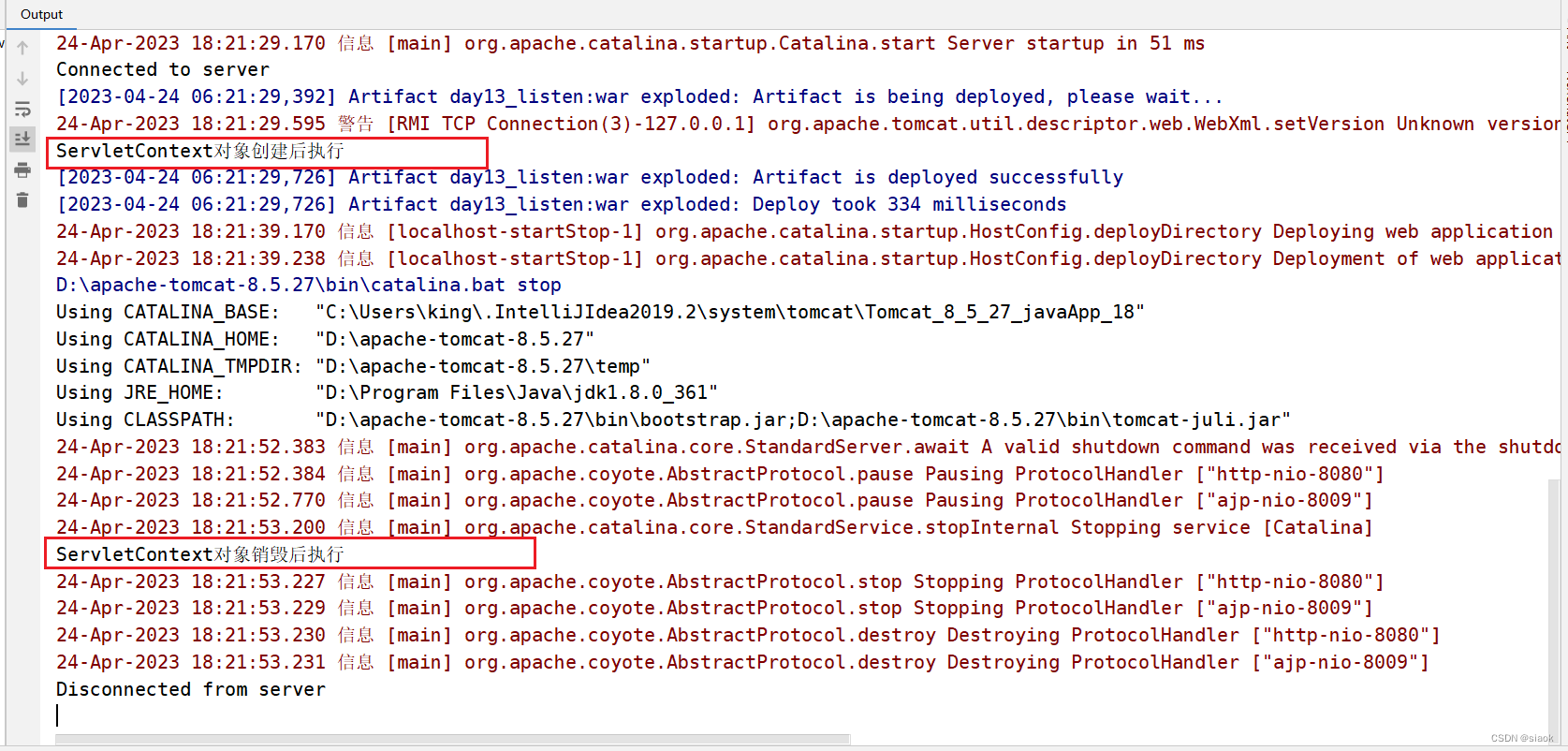编译软件:IntelliJ IDEA 2019.2.4 x64
操作系统:win10 x64 位 家庭版
服务器软件:apache-tomcat-8.5.27
一. Servlet监听器是什么?
用官方一点的说法来说,“它是基于Java Servlet 规范的对象,主要用于监听Web应用程序中的ServletContext,HttpSession 和HttpServletRequest等域对象的创建与销毁事件,以及监听这些域对象中的属性发生修改的事件”,非常精辟的表述。
但这些话可能对新手小白来说不是很理解。莫急,个人理解,它就像我们现实生活中的窃听器一样,对某些特定的群体进行窃听,基于监听目标的特定行为事件进行相应的反应,比如臭名昭著的美国棱镜门窃听事件。
二. Servlet监听器有哪些作用?
2.1 监听域对象的创建和销毁
2.1.1 ServletContextListener接口
作用:
监听ServletContext对象(全局上下文对象)的创建与销毁
| 方法名 | 作用 |
|---|---|
| contextInitialized(ServletContextEvent sce) | ServletContext创建时调用 |
| contextDestroyed(ServletContextEvent sce) | ServletContext销毁时调用 |
附注:
ServletContext对象是在 web项目被加载时(Tomcat服务器开机)创建,但在web项目卸载时销毁(Tomcat服务器关机)
2.1.2 HttpSessionListener接口
作用:
监听HttpSession对象(会话域对象)的创建与销毁
| 方法名 | 作用 |
|---|---|
| sessionCreated(HttpSessionEvent hse) | HttpSession对象创建时调用 |
| sessionDestroyed(HttpSessionEvent hse) | HttpSession对象销毁时调用 |
附注:
HttpSession对象是在第一次调用getSession方法时创建,但在客户端关闭,强制失效,达到最大空闲时间时自动失效等三类情形下销毁对象。
2.1.3 ServletRequestListener接口
作用:
监听ServletRequest对象(请求域对象)的创建与销毁
| 方法名 | 作用 |
|---|---|
| requestInitialized(ServletRequestEvent sre) | ServletRequest对象创建时调用 |
| requestDestroyed(ServletRequestEvent sre) | ServletRequest对象销毁时调用 |
附注:
ServletRequest对象是在有请求就创建,但在响应结束时就销毁。
2.2 监听域对象内共享数据的添加、修改、删除
2.2.1 ServletContextAttributeListener接口
作用:
监听ServletContext对象中属性的添加、移除和修改
| 方法名 | 作用 |
|---|---|
| attributeAdded(ServletContextAttributeEvent scab) | 向ServletContext中添加属性时调用 |
| attributeRemoved(ServletContextAttributeEvent scab) | 从ServletContext中移除属性时调用 |
| attributeReplaced(ServletContextAttributeEvent scab) | 当ServletContext中的属性被修改时调用 |
ServletContextAttributeEvent对象代表属性变化事件,它包含的方法如下:
| 方法名 | 作用 |
|---|---|
| getName() | 获取修改或添加的属性名 |
| getValue() | 获取被修改或添加的属性值 |
| getServletContext() | 获取ServletContext对象 |
2.2.2 HttpSessionAttributeListener接口
作用:
监听HttpSession对象中属性的添加、移除和修改
| 方法名 | 作用 |
|---|---|
| attributeAdded(HttpSessionBindingEvent se) | 向HttpSession中添加属性时调用 |
| attributeRemoved(HttpSessionBindingEvent se) | 从HttpSession中移除属性时调用 |
| attributeReplaced(HttpSessionBindingEvent se) | 当HttpSession中的属性被修改时调用 |
HttpSessionBindingEvent对象代表属性变化事件,它包含的方法如下:
| 方法名 | 作用 |
|---|---|
| getName() | 获取修改或添加的属性名 |
| getValue() | 获取被修改或添加的属性值 |
| getSession() | 获取触发事件的HttpSession对象 |
2.2.3 ServletRequestAttributeListener接口
作用:
监听ServletRequest对象中属性的添加、移除和修改
| 方法名 | 作用 |
|---|---|
| attributeAdded(ServletRequestAttributeEvent srae) | 向ServletRequest中添加属性时调用 |
| attributeRemoved(ServletRequestAttributeEvent srae) | 从ServletRequest中移除属性时调用 |
| attributeReplaced(ServletRequestAttributeEvent srae) | 当ServletRequest中的属性被修改时调用 |
ServletRequestAttributeEvent对象代表属性变化事件,它包含的方法如下:
| 方法名 | 作用 |
|---|---|
| getName() | 获取修改或添加的属性名 |
| getValue() | 获取被修改或添加的属性值 |
| getServletRequest () | 获取触发事件的ServletRequest对象 |
三. 怎样创建一个Servlet监听器?
步骤:
①创建一个类
②实现一个接口
根据业务场景需要可参选实现三者(ServletContextListener,HttpSessionListener,或ServletRequestListener)之一的接口使用
③实现接口中的抽象方法
④注册监听器(最原始的做法)
位置:
在web.xml中注册
代码示例如下:
//注册刚创建的监听器MyListener
<listener>
<listener-class>Listenner.MyListener</listener-class>
</listener>
四. 练手案例
案例:创建监听器MyListener类,继承ServletContextListener接口,用于监听全局上下文对象的创建与销毁情况,并在web.xml中注册该监听器。演示监听器观察全局上下文对象的创建与销毁。
①创建MyListener类,继承ServletContextListener接口
代码示例如下:
import javax.servlet.ServletContextEvent;
import javax.servlet.ServletContextListener;
//监听ServletContext应用域对象
public class MyListener implements ServletContextListener {
@Override
public void contextInitialized(ServletContextEvent servletContextEvent) {
System.out.println("ServletContext对象创建后执行");
}
@Override
public void contextDestroyed(ServletContextEvent servletContextEvent) {
System.out.println("ServletContext对象销毁后执行");
}
}
②在web.xml里注册该监听器
代码示例如下:
<listener>
<listener-class>Listener.MyListener</listener-class>
</listener>
